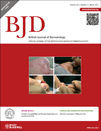Thalidomide in the treatment of refractory cutaneous lupus erythematosus: prognostic factors of clinical outcome
Funding sources None.
Conflicts of interest None declared.
Summary
Background Although thalidomide has been shown to be effective in patients with refractory cutaneous lupus erythematosus (CLE), its use is still hampered by its potential severe side-effects and the current restricted availability.
Objectives To evaluate prospectively the clinical efficacy and safety of low-dose thalidomide in an observational study and to establish prognostic factors of clinical outcome.
Methods Sixty consecutive patients with refractory CLE were treated with thalidomide (100 mg daily). Clinical response was assessed by the CLE Disease Area and Severity Index (CLASI). Clinical and immunological parameters were evaluated during treatment.
Results Patients were followed for up to 8 years (range 2–18). One patient discontinued treatment because of side-effects. Of the 59 remaining patients, 58 (98%) achieved clinical response, already noticeable at 2 weeks following treatment. Complete response occurred in 50 patients (85%). Clinical relapse was frequent (70%) and usually occurred 5 months after withdrawal or reduction of thalidomide. Subacute CLE (SCLE) was the predicting factor of long-term remission after therapy discontinuation [odds ratio (OR) 30, 95% confidence interval (CI) 5·82–154·63], whereas discoid lupus erythematosus (DLE) was predictive of relapse (OR 5·71, 95% CI 1·36–24·06). Eleven patients (18%) reported paraesthesia; in five of the 11, nerve conduction studies confirmed a sensory polyneuropathy. Neurological symptoms resolved in 12 months (range 6–18) after thalidomide withdrawal. Two patients, heavy smokers and without antiphospholipid antibodies, had a cerebral ischaemic event.
Conclusions Low-dose thalidomide is an effective treatment for refractory CLE, but its benefits need to be balanced against the potential adverse effects. Whereas DLE forms tended to relapse and required a long-term maintenance dose of thalidomide, SCLE forms showed a sustained remission after withdrawal.




